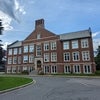Colleges Don’t See Big Impact If Student Loan Rates Rise
The potential doubling of interest rates on new federally backed loans for college students has Central Massachusetts colleges frustrated for their students, but not expecting major impacts.
There is bi-partisan support in Congress to freeze the rate for a year at a $6-billion price tag, but disagreement over how to pay for it. If Congress doesn’t act, the interest rate will jump from 3.4 percent to 6.8 percent on loans taken out after July 1, returning to the rate they were at in 2007, when the College Cost Reduction and Access Act took effect, gradually dropping rates through the 2011-2012 school year. Subsidized federal Stafford loans are available to low- and middle-income students and interest does not accrue until the students are out of school.
“It’s outrageous that it’s going to such a high interest rate,” said Lynne Myers, director of financial aid for the College of the Holy Cross in Worcester. “Families brought it up at some of our open houses. It just seems ludicrous to have interest rates going up on student loans during a time when the whole conversation is about affordability of higher education.”
Politics As Usual
Given the relatively low impact the interest rate hike is expected to have, at $1,000 added to each loan, financial aid administrators recognize the national attention being put on the issue as being part of the political game in an election year.
“It’s definitely gotten magnified by the election,” said Jon Fansmith, associate director of government relations at the nonprofit American Council on Education. “We’re sort of used to a certain level of exposure … Clearly the administration has made this a real point of emphasis, and the Republicans, I think, have matched that.”
Jayne McGinn, Worcester State University’s director of financial aid, feels that coverage of the issue has been misleading in that it doesn’t address the fact that subsidies paid between a student’s graduation and the end of a six-month grace period will disappear as of July 1, as will all subsidies on federal loans for graduate students.
McGinn believes the focus has been put on the interest rate because it’s an easy-to-understand talking point for an election year.
Support For Stafford Loans
Regardless of the outcome, financial aid counselors continue to support Stafford loans as the best borrowing option for students because they don’t allow borrowing much beyond what’s needed, have flexible repayment options and lower interest rates than private loans.
Officials at Central Massachusetts colleges and universities have differing outlooks on the potential impact of an increase.
“The students don’t see enough of that impact to have it be an impact in decision making,” Myers said. “It would take much more than a slight fluctuation like this to impact enrollment at Holy Cross.”
Fansmith noted that most students take out both subsidized and unsubsidized loans and that the interest rate on the unsubsidized loans is already 6.8 percent.
More Attention To Debt Load
But Linda Mularczyk, director of financial aid at Assumption College in Worcester, said, “It definitely will have an impact because (students will) start looking at the debt that it will cost them to go to one school over the other and they’ll forget about the value that one school has over the other.”
According to the school’s website, the total cost of attendance for a full-time student for the 2012-2013 school year will be $33,805.
Despite Mularczyk’s concerns, public universities in the region aren’t necessarily assuming the higher interest rates will benefit them.
Pam McCafferty, dean of enrollment management at Fitchburg State University, noted that the most a student can borrow in one federal loan is $7,500 and said, “At a public institution, that does represent a significant portion of the bill. But at a private (school), it represents a small amount, so families are already finding other ways to finance. If people were making decisions based on this, I think it would be kind of a misunderstanding or misconception.”
Applications Up At Worcester State
McGinn said WSU saw an influx in applications from people who would otherwise have applied to private schools, beginning during the recession in 2008 and 2009. WSU has yet to post its costs for 2012-2013, but for 2011-2012, tuition and fees for Massachusetts residents were $7,653.
If rates do increase, McGinn doesn’t think it will deter students from borrowing.
“I think students will keep borrowing because they need to pay for their cost of attendance,” she said. “What we want to do is try to educate them more on the effect of the borrowing.”
Fansmith explained that the increase could factor into a low-income student’s choice of what college to attend, but there are too many other factors involved in choosing a school to know for certain whether loan costs would affect their decision. He also doesn’t expect the colleges to see many changes.
“The impact of this really is less on the institutions directly and much more on the students themselves,” he said. n









0 Comments